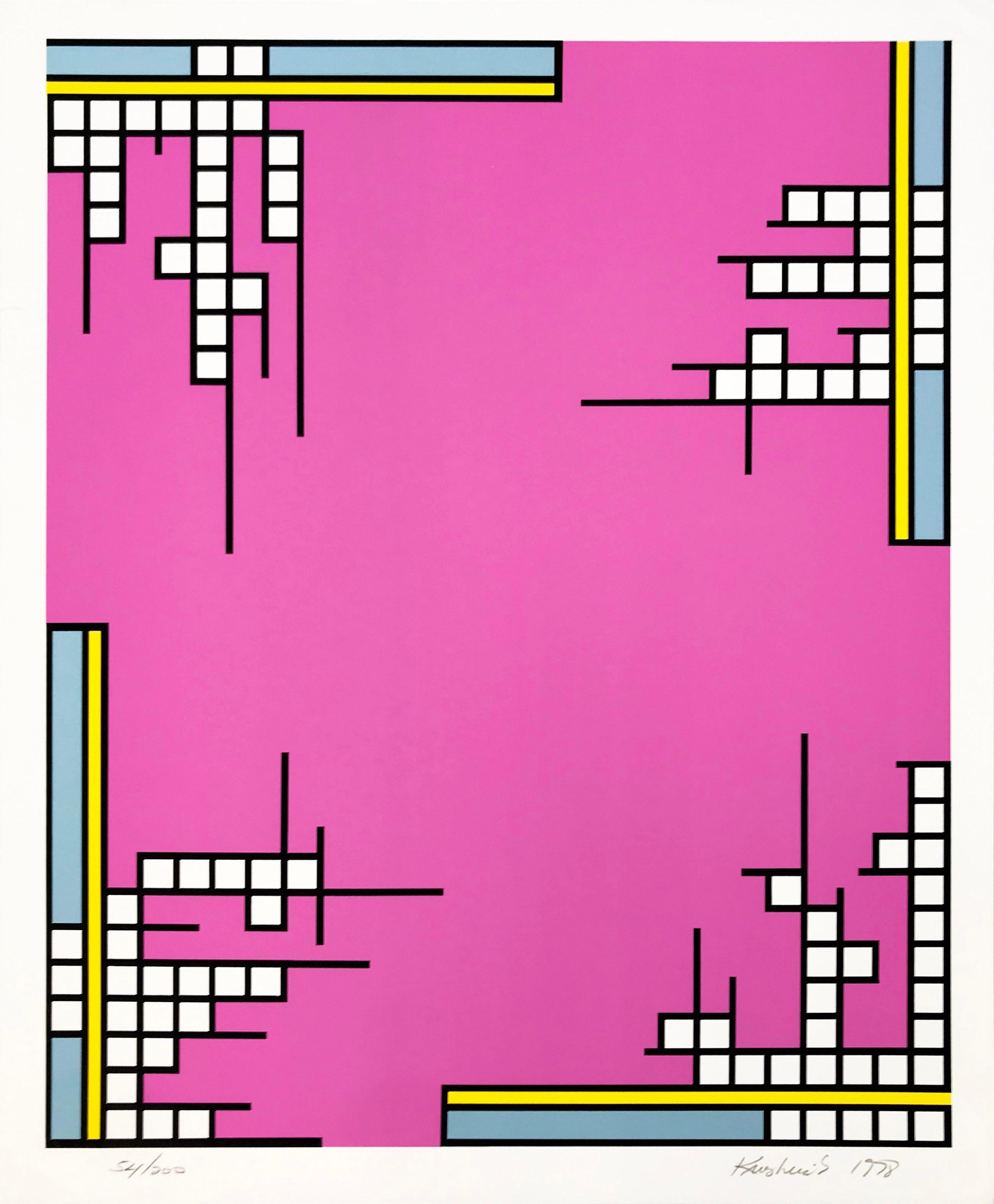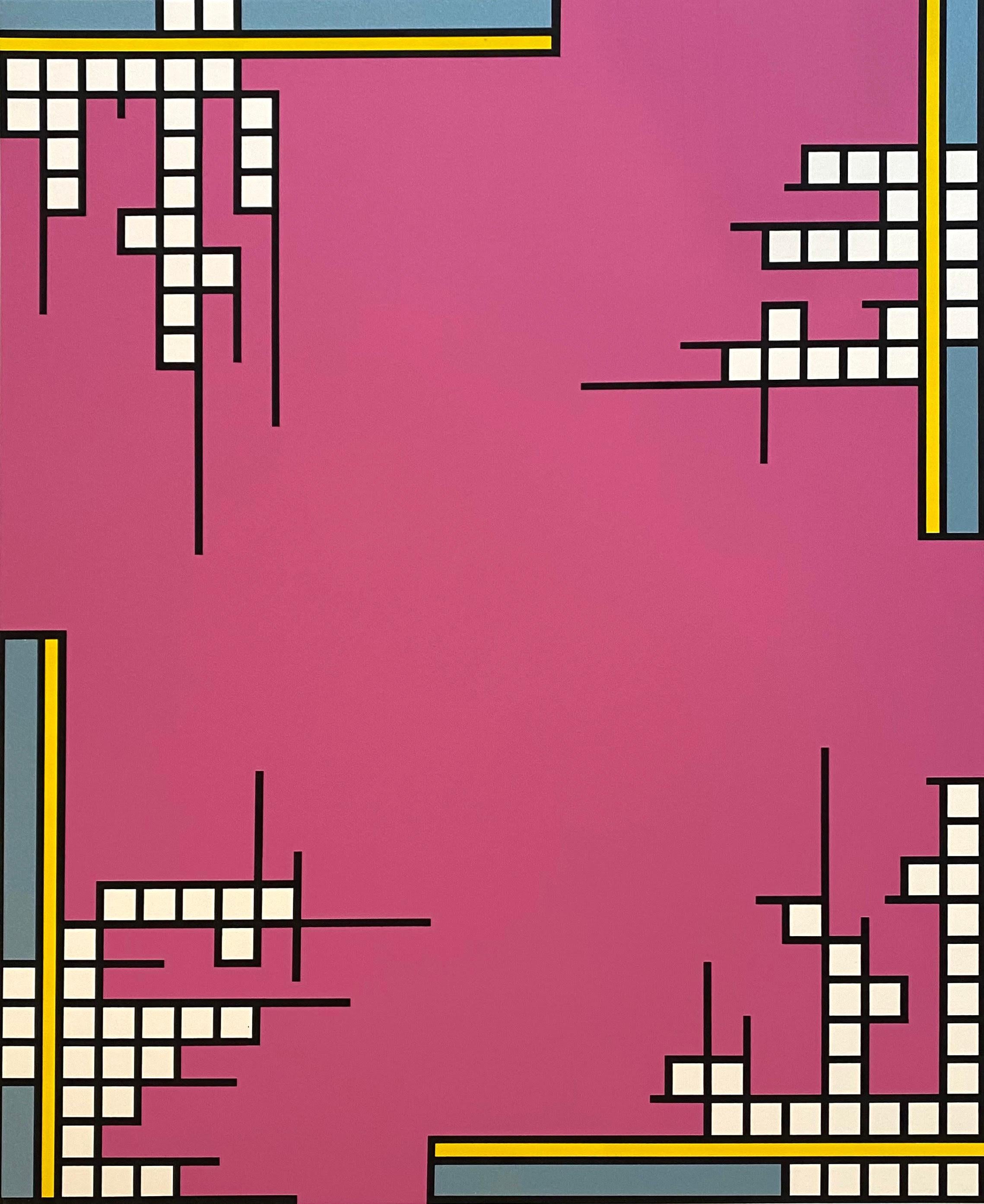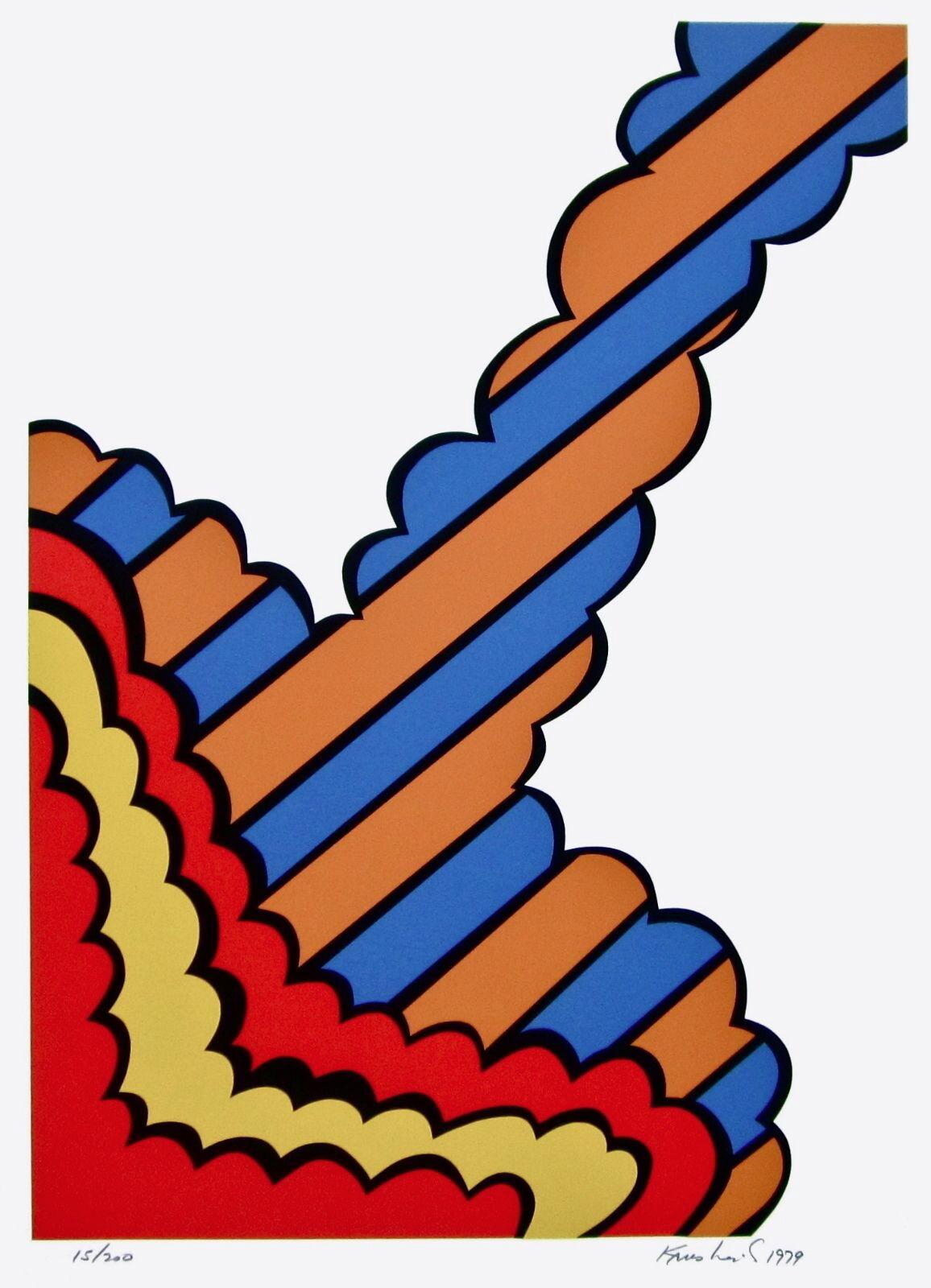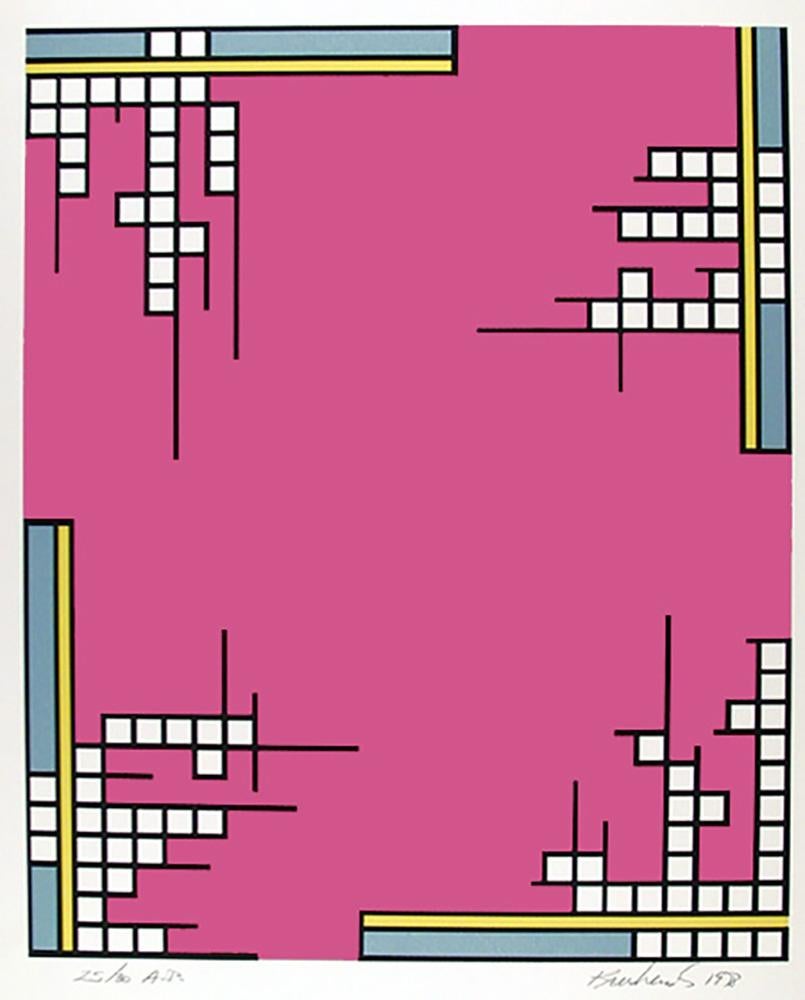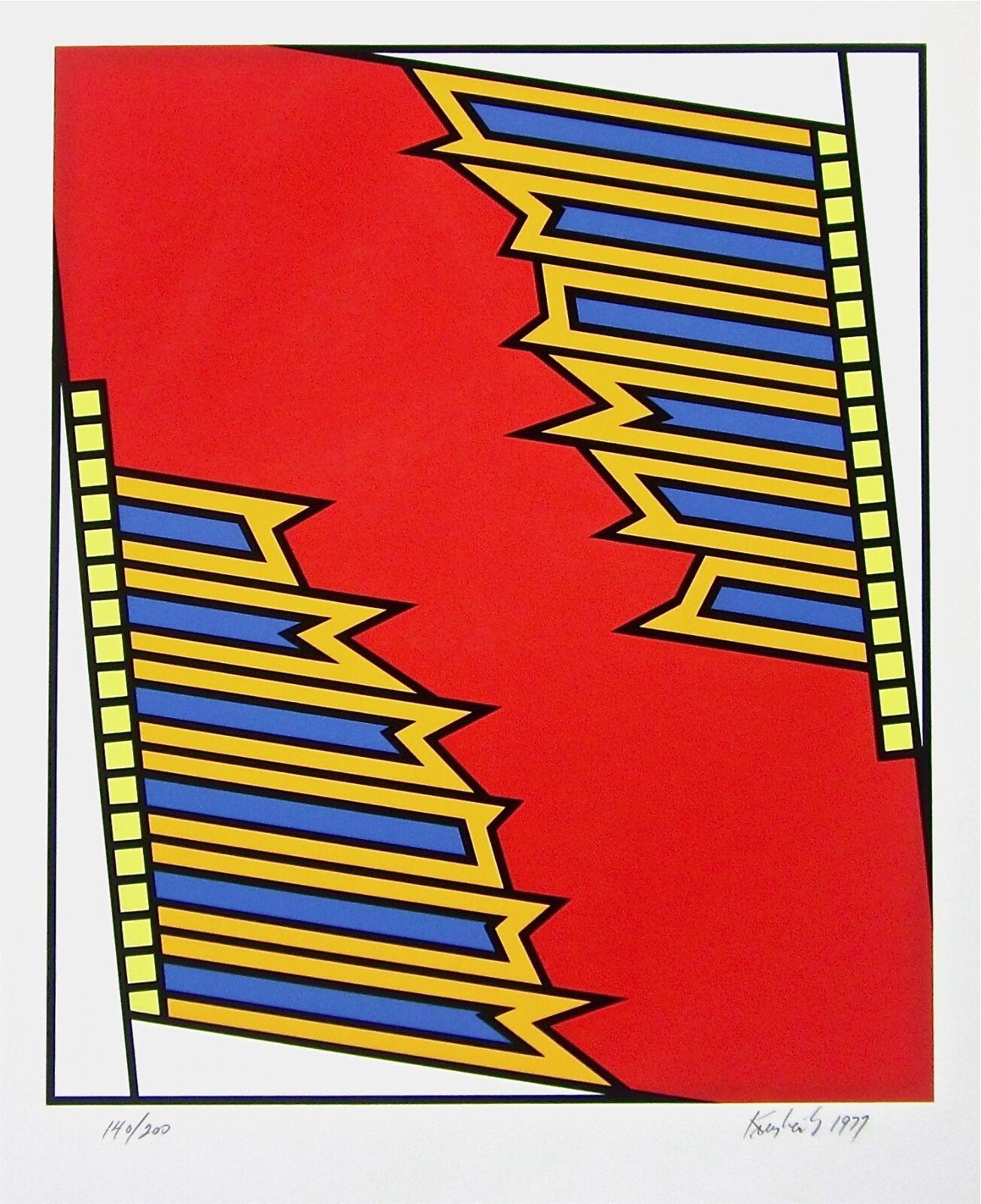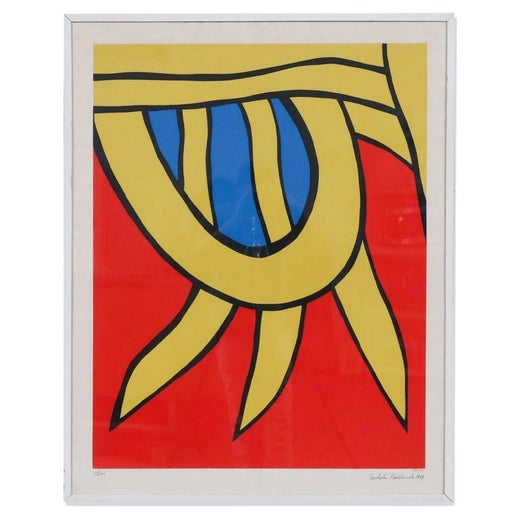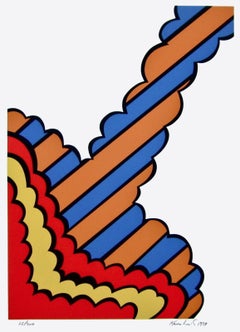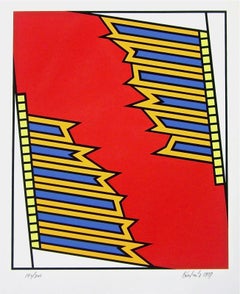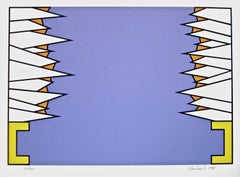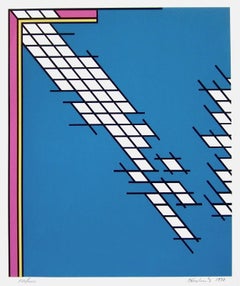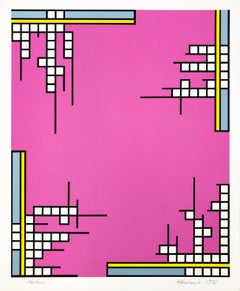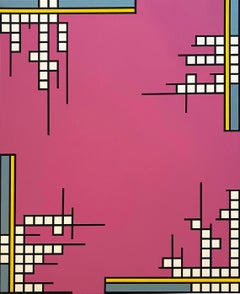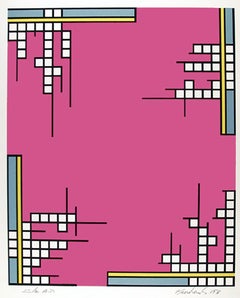Items Similar to Over the Top, Nicholas Krushenick
Want more images or videos?
Request additional images or videos from the seller
1 of 5
Nicholas KrushenickOver the Top, Nicholas Krushenick1977
1977
$1,000
$1,25020% Off
£758.87
£948.5920% Off
€868.97
€1,086.2120% Off
CA$1,421.07
CA$1,776.3420% Off
A$1,546.66
A$1,933.3320% Off
CHF 811.98
CHF 1,014.9820% Off
MX$18,685.93
MX$23,357.4120% Off
NOK 10,191.29
NOK 12,739.1120% Off
SEK 9,609.18
SEK 12,011.4820% Off
DKK 6,486.77
DKK 8,108.4720% Off
About the Item
Artist: Nicholas Krushenick (1929-1999)
Title: Over the Top
Year: 1978
Edition: 3/200, plus proofs
Medium: Silkscreen on wove paper
Size: 32.5 x 26 inches
Condition: Good
Inscription: Signed and numbered by the artist.
NICHOLAS KRUSHENICK (1929-1999) One of America’s premier Pop artists, Nicholas Krushenick’s work consists of geometric abstract motifs whose shapes were outlined in heavy black lines. In this regard his original prints were often compared to those of Pop Art co-horts Roy Lichtenstein and Andy Warhol, but unlike these masters Krushenick avoided any imagery from commercial art. More than one critic termed the art of Krushenick as "Abstract Pop." Today his prints and paintings are included in such major collections as the Stedelijk, Amsterdam, the Walker Art Center, Minneapolis, the Los Angeles County Museum of Art, the Whitney Museum of American Art, the Metropolitan Museum of Art and the Museum of Modern Art, New York.
- Creator:Nicholas Krushenick (1929-1999, American)
- Creation Year:1977
- Dimensions:Height: 32 in (81.28 cm)Width: 26 in (66.04 cm)
- Medium:
- Movement & Style:
- Period:
- Condition:
- Gallery Location:Fairfield, CT
- Reference Number:1stDibs: LU1342111077652
Nicholas Krushenick
orn in the Bronx, New York in 1929, Nicholas Krushenick studied painting at the Art Students League of New York and the Hans Hofmann School of Fine Arts. After completing his training, Krushenick designed window displays and worked in the Framing Department of the Museum of Modern Art. From 1957 to 1962, the artist, along with his brother John, operated the now legendary Brata Gallery in Manhattan’s East Village. Brata displayed the works of many of the foremost artists of the day, including, among others: Ronald Bladen, Ed Clarke, Al Held, Yayoi Kusama, and George Sugarman. Krushenick first developed his signature “pop abstract” style in the early 1960s. The loose geometries and web-like forms of his early paintings demonstrate his deliberate caricature of Abstract Expressionist “drips” or “skeins” into what more closely resemble details from cartoons—like Superman’s hair follicles, as critic Robert Rosenblum once described. The high-keyed color, formal rigor, and sheer graphic intensity of his paintings set Krushenick apart from his contemporaries. As a result, decades after its creation, Krushenick’s work still appears remarkably fresh. During the 1960s and 1970s, Krushenick had solo exhibitions at many of the most influential and prestigious galleries, including: Graham Gallery (1958, 1962, 1964, New York), Fischbach Gallery (1965, New York), Galerie Sonnabend (1967, Paris), Galerie Ziegler (1969, Zürich), Galerie Beyeler (1971, Basel), and Pace Gallery (1967, 1969, 1972, New York). During this period, his work also figured prominently in many landmark museum exhibitions, such as Post Painterly Abstraction (1964, Los Angeles County Museum of Art), Vormen van de Kleur (1964, Stedelijk Museum), Systemic Painting (1965, Solomon R. Guggenheim Museum), and Documenta 4 (1968, Fredericianum), among others. In 1968, the Walker Art Center mounted a retrospective exhibition of Krushenick’s work. His first European retrospective came four years later, in 1972, at the Kestner-Gesellschaft in Hannover, Germany. In 2015 he had a retrospective at the Tang Gallery, Skidmore College, Saratoga Springs, New York entitled Nicholas Krushenick: Electric Soup. Krushenick’s work is featured in the collections of over sixty major museums, including: the Albright-Knox Art Gallery; the Baltimore Museum of Art; the Cleveland Museum of Art; the Dallas Museum of Fine Art; the Empire State Art Collection; the Grey Art Gallery, New York University; the Los Angeles County Museum of Art; the Metropolitan Museum of Art; the Museum of Modern Art; San Francisco Museum of Modern Art; the Smithsonian American Art Museum, Washington, D.C.; the Stedelijk Museum; the Virginia Museum of Fine Arts, Richmond; the Walker Art Center, Minneapolis; and the Whitney Museum of American Art.
About the Seller
5.0
Vetted Professional Seller
Every seller passes strict standards for authenticity and reliability
Established in 2002
1stDibs seller since 2020
902 sales on 1stDibs
Typical response time: <1 hour
- ShippingRetrieving quote...Shipping from: Fairfield, CT
- Return Policy
Authenticity Guarantee
In the unlikely event there’s an issue with an item’s authenticity, contact us within 1 year for a full refund. DetailsMoney-Back Guarantee
If your item is not as described, is damaged in transit, or does not arrive, contact us within 7 days for a full refund. Details24-Hour Cancellation
You have a 24-hour grace period in which to reconsider your purchase, with no questions asked.Vetted Professional Sellers
Our world-class sellers must adhere to strict standards for service and quality, maintaining the integrity of our listings.Price-Match Guarantee
If you find that a seller listed the same item for a lower price elsewhere, we’ll match it.Trusted Global Delivery
Our best-in-class carrier network provides specialized shipping options worldwide, including custom delivery.More From This Seller
View AllNorth End, Nicholas Krushenick
By Nicholas Krushenick
Located in Fairfield, CT
Artist: Nicholas Krushenick (1929-1999)
Title: North End
Year: 1979
Edition: 15/200, plus proofs
Medium: Silkscreen on wove paper
Size: 36 x 26 inches
Condition: Good
Inscription: Signed and numbered by the artist.
NICHOLAS KRUSHENICK (1929-1999) One of America’s premier Pop artists, Nicholas Krushenick’s work consists of geometric abstract motifs whose shapes were outlined in heavy black lines. In this regard his original prints were often compared to those of Pop Art co-horts Roy Lichtenstein and Andy Warhol, but unlike these masters Krushenick avoided any imagery from commercial art...
Category
1970s Pop Art Abstract Prints
Materials
Screen
$876 Sale Price
20% Off
Silver Liner, Nicholas Krushenick
By Nicholas Krushenick
Located in Fairfield, CT
Artist: Nicholas Krushenick (1929-1999)
Title: Silver Liner
Year: 1977
Edition: 140/200, plus proofs
Medium: Silkscreen on wove paper
Size: 32 x 26 inches
Condition: Good
Inscription...
Category
1970s Pop Art Abstract Prints
Materials
Screen
$1,196 Sale Price
20% Off
Over the Rainbow, Nicholas Krushenick
By Nicholas Krushenick
Located in Fairfield, CT
Artist: Nicholas Krushenick (1929-1999)
Title: Over the Rainbow
Year: 1978
Edition: 24/200, plus proofs
Medium: Silkscreen on wove paper
Size: 27.75 x 37.75 inches
Condition: Good
In...
Category
1970s Pop Art Abstract Prints
Materials
Screen
$876 Sale Price
20% Off
Tailgate, Nicholas Krushenick
By Nicholas Krushenick
Located in Fairfield, CT
Artist: Nicholas Krushenick (1929-1999)
Title: Tailgate
Year: 1978
Edition: 150/200, plus proofs
Medium: Silkscreen on wove paper
Size: 30.5 x 26 inches
Condition: Good
Inscription: ...
Category
1970s Pop Art Abstract Prints
Materials
Screen
$1,000 Sale Price
20% Off
Ascension, Roy Ahlgren
Located in Fairfield, CT
Artist: Roy Ahlgren (1926-2011)
Title: Ascension
Year: 1978
Edition: A.P./90, plus proofs
Medium: Silkscreen on Arches paper
Size: 26 x 20 inches
Condition: Good
Inscription: Signed ...
Category
1970s Pop Art Landscape Prints
Materials
Screen
$876 Sale Price
20% Off
Three Square Composition, Larry Zox
By Larry Zox
Located in Fairfield, CT
Artist: Larry Zox (1937-2006)
Title: Three Square Composition
Year: 1978
Edition: VII/LX; 200 Arabic Numeral, 60 Roman Numeral, plus proofs
Medium: Silkscreen on Arches paper
Size: 2...
Category
1970s Pop Art Landscape Prints
Materials
Screen
$6,000 Sale Price
20% Off
You May Also Like
OVER THE TOP
By Nicholas Krushenick
Located in Aventura, FL
Screenprint in colors on paper. Hand signed, dated and numbered by the artist. Sheet size 31 x 26 inches. Image size approx 29 x 23.75 inches. From the edition of 200. Certificate...
Category
2010s Contemporary Figurative Prints
Materials
Paper, Screen
$770 Sale Price
30% Off
Nicholas Krushenick Over the Top
By Nicholas Krushenick
Located in Washington, DC
Artist: Nicholas Krushenick
Title: Over the Top
Medium: Silkscreen
Year: 1980
Edition: 134/200
Sheet Size: 29" x 24"
Frame Size: 33 1/2" x 28 1/4"
Signed:...
Category
1980s Abstract Abstract Prints
Materials
Screen
Ohne Titel
By Nicholas Krushenick
Located in San Francisco, CA
This artwork titled "Ohne Titel" 1973 is an original color silkscreen by noted New York artist Nicholas Krushenick, 1929-1999. It is hand signed, dated and ...
Category
Late 20th Century Abstract Expressionist Abstract Prints
Materials
Screen
Over the Top, Abstract Geometric Screenprint by Nicholas Krushenick
By Nicholas Krushenick
Located in Long Island City, NY
Artist: Nicholas Krushenick
Title: Over the Top
Year: 1978
Medium: Screenprint, signed and numbered in pencil
Edition: 200, AP 30
Image Size: 29 x 24 in. ...
Category
1980s Abstract Geometric Abstract Prints
Materials
Screen
Untitled VI, Geometric Pop Art Screenprint by Nicholas Krushenick
By Nicholas Krushenick
Located in Long Island City, NY
Artist: Nicholas Krushenick, American (1929 - 1999)
Title: Untitled VI from Fire-Flash-Fire-Fade Portfolio
Year: 1971
Medium: Screenprint, signed and numbered in pencil
Edition: 150
...
Category
1970s Pop Art Abstract Prints
Materials
Screen
Big Sky, Pop Abstract Silkscreen by Nicholas Krushenick
By Nicholas Krushenick
Located in Long Island City, NY
Artist: Nicholas Krushenick, American (1929 - 1999)
Title: Big Sky
Year: 1980
Medium: Silkscreen, signed and numbered in pencil
Edition: 200; AP 30
Size: 40 x 34 inches (101.6 x 86...
Category
1980s Abstract Abstract Prints
Materials
Screen
